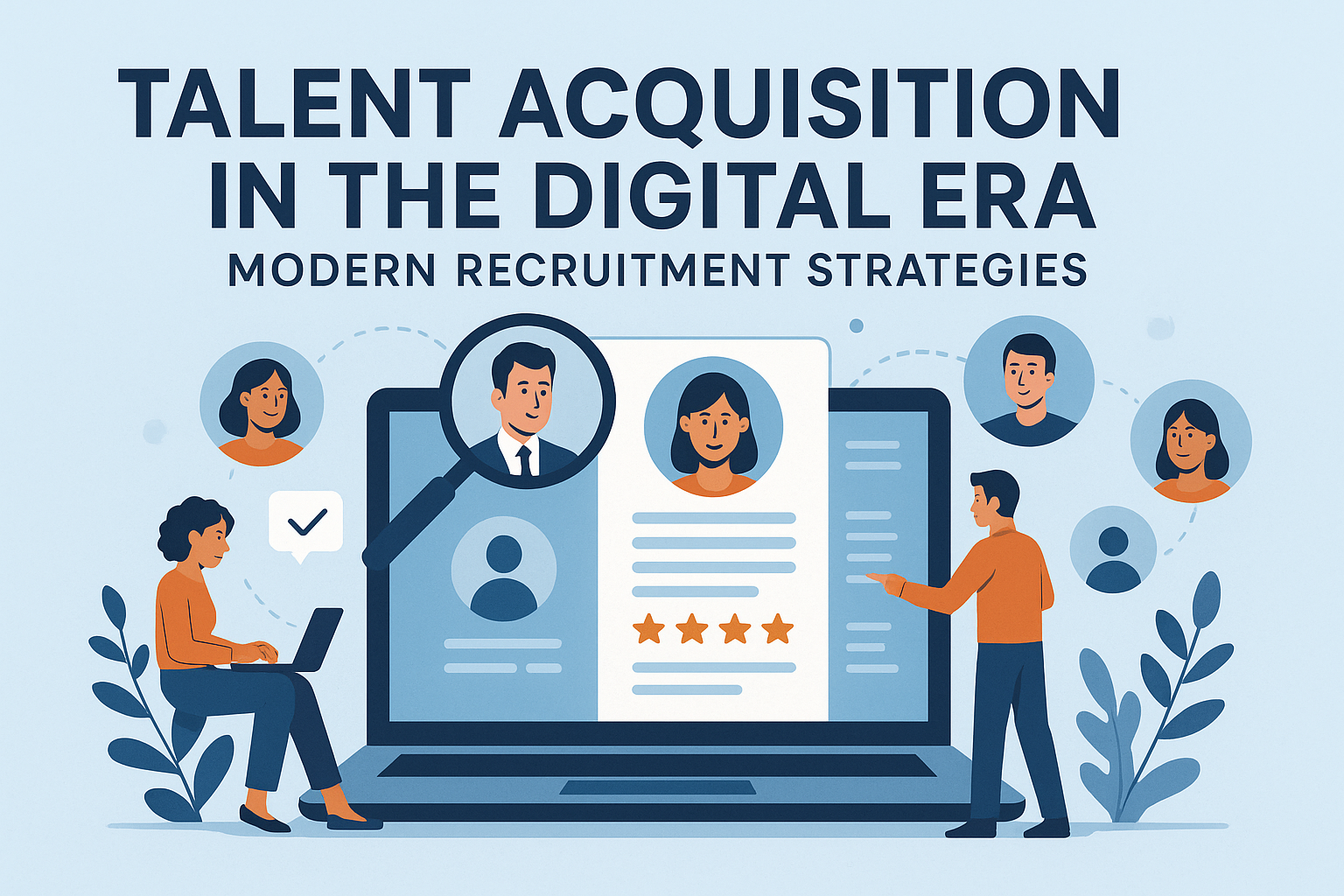
Talent Acquisition in the Digital Era: Modern Recruitment Strategies
The digital transformation has revolutionized talent acquisition, creating new opportunities and challenges for recruiters and hiring managers. Organizations that adapt to modern recruitment strategies gain competitive advantages in attracting, evaluating, and securing top talent.
The Evolution of Talent Acquisition
Traditional vs. Digital Recruitment
Key differences in recruitment approaches:
- Sourcing: From job boards to social media and AI-powered platforms
- Screening: From manual resume review to automated candidate matching
- Assessment: From in-person interviews to virtual evaluation methods
- Communication: From phone calls to multi-channel digital communication
- Decision-Making: From gut feeling to data-driven insights
Digital Transformation Impact
How technology is reshaping recruitment:
- Expanded Reach: Global talent pool access
- Improved Efficiency: Automated screening and scheduling
- Enhanced Experience: Better candidate journey management
- Data-Driven Decisions: Analytics-based hiring choices
- Cost Effectiveness: Reduced recruitment costs
Modern Recruitment Technology Stack
Core Recruitment Tools
Essential technologies for modern talent acquisition:
- Applicant Tracking Systems (ATS): Centralized recruitment management
- AI-Powered Screening: Automated candidate evaluation
- Video Interview Platforms: Remote interview capabilities
- Social Media Recruiting: Leveraging social networks for sourcing
- Candidate Relationship Management: Long-term talent pipeline development
Emerging Technologies
Next-generation recruitment tools:
- Machine Learning: Predictive candidate matching
- Chatbots: Automated candidate engagement
- Virtual Reality: Immersive job previews
- Blockchain: Credential verification
- Predictive Analytics: Hiring success forecasting
Candidate Experience Optimization
Journey Mapping
Understanding the candidate experience:
- Awareness Stage: How candidates discover opportunities
- Application Process: Streamlining the application experience
- Evaluation Phase: Transparent and timely communication
- Decision Stage: Clear and prompt decision-making
- Onboarding: Smooth transition to employment
Digital Touchpoints
Optimizing candidate interactions:
- Career Website: Engaging employer brand presentation
- Mobile Experience: Mobile-optimized application process
- Social Media: Authentic employer brand representation
- Email Communication: Personalized and timely messaging
- Virtual Interviews: Professional and efficient interview experience
Data-Driven Recruitment
Recruitment Analytics
Key metrics for talent acquisition success:
- Time to Fill: Speed of recruitment process
- Cost per Hire: Recruitment expense efficiency
- Quality of Hire: Long-term employee performance
- Candidate Satisfaction: Experience feedback scores
- Source Effectiveness: Channel performance analysis
Predictive Analytics
Using data to improve hiring decisions:
- Candidate Success Prediction: Identifying high-potential candidates
- Retention Forecasting: Predicting employee longevity
- Skill Gap Analysis: Identifying future talent needs
- Market Intelligence: Understanding talent market trends
- Bias Detection: Identifying and reducing hiring bias
Sourcing Strategies for Digital Age
Multi-Channel Sourcing
Diversifying talent acquisition channels:
- Professional Networks: LinkedIn and industry platforms
- Social Media: Facebook, Twitter, and Instagram recruiting
- Job Boards: Traditional and niche job posting sites
- Employee Referrals: Leveraging internal networks
- Passive Candidate Engagement: Reaching non-active job seekers
Employer Branding
Building attractive employer brand:
- Company Culture: Authentic workplace culture representation
- Employee Stories: Genuine employee testimonials
- Social Responsibility: Corporate social responsibility initiatives
- Career Development: Growth and advancement opportunities
- Work-Life Balance: Flexible work arrangements and benefits
Assessment and Evaluation Methods
Modern Assessment Techniques
Innovative candidate evaluation methods:
- Skills-Based Assessments: Practical skill demonstrations
- Cultural Fit Evaluation: Values and culture alignment assessment
- Behavioral Interviews: Competency-based interview techniques
- Cognitive Assessments: Problem-solving and critical thinking evaluation
- Peer Interviews: Team-based evaluation processes
Virtual Assessment Tools
Remote evaluation capabilities:
- Online Skill Tests: Technical and soft skill assessments
- Video Interviewing: Remote interview platforms
- Virtual Job Simulations: Work scenario evaluations
- Collaborative Assessments: Team-based evaluation exercises
- AI-Powered Analysis: Automated candidate evaluation
Diversity and Inclusion in Recruitment
Inclusive Recruitment Strategies
Building diverse talent pipelines:
- Bias-Free Job Descriptions: Inclusive language and requirements
- Diverse Sourcing: Reaching underrepresented talent pools
- Structured Interviews: Standardized evaluation processes
- Diverse Interview Panels: Inclusive evaluation teams
- Unconscious Bias Training: Recruiter and hiring manager education
Measuring Diversity Impact
Tracking diversity and inclusion progress:
- Diversity Metrics: Representation across demographics
- Inclusion Indicators: Employee engagement and satisfaction
- Promotion Rates: Career advancement equity
- Retention Analysis: Turnover by demographic groups
- Pay Equity: Compensation fairness assessment
Recruitment Process Optimization
Streamlining Workflows
Improving recruitment efficiency:
- Process Automation: Automating routine tasks
- Standardized Procedures: Consistent evaluation processes
- Communication Templates: Efficient candidate communication
- Decision-Making Frameworks: Clear evaluation criteria
- Feedback Loops: Continuous process improvement
Candidate Pipeline Management
Building sustainable talent pipelines:
- Talent Communities: Engaging potential candidates
- Relationship Building: Long-term candidate engagement
- Regular Communication: Periodic touchpoint maintenance
- Opportunity Matching: Aligning candidates with suitable roles
- Pipeline Analytics: Measuring pipeline health
Remote Hiring Strategies
Virtual Recruitment Process
Adapting to remote hiring:
- Digital Onboarding: Remote new hire integration
- Virtual Team Introductions: Digital team meeting facilitation
- Remote Work Assessment: Evaluating remote work capabilities
- Technology Setup: Ensuring remote work readiness
- Culture Integration: Virtual culture immersion
Managing Remote Teams
Leading distributed recruitment teams:
- Communication Protocols: Clear virtual communication standards
- Performance Management: Remote team performance tracking
- Collaboration Tools: Technology for team coordination
- Training and Development: Remote skill development programs
- Team Building: Virtual team connection activities
Future of Talent Acquisition
Emerging Trends
Future developments in recruitment:
- AI-Powered Recruitment: Intelligent candidate matching
- Gig Economy Integration: Flexible workforce management
- Skills-Based Hiring: Competency-focused recruitment
- Continuous Recruitment: Always-on talent acquisition
- Employee Experience: Holistic career journey management
Strategic Considerations
Long-term talent acquisition planning:
- Workforce Planning: Future talent needs forecasting
- Skill Development: Internal capability building
- Succession Planning: Leadership pipeline development
- Global Talent: International recruitment strategies
- Technology Investment: Recruitment technology roadmap
Conclusion
Modern talent acquisition requires a strategic approach that combines technology, data analytics, and human insight to attract, evaluate, and hire top talent. By embracing digital tools, optimizing candidate experiences, and implementing data-driven processes, organizations can build competitive advantages in today's talent market.
The key to success is balancing efficiency with personalization, ensuring that technological advancement enhances rather than replaces the human elements that make recruitment successful.